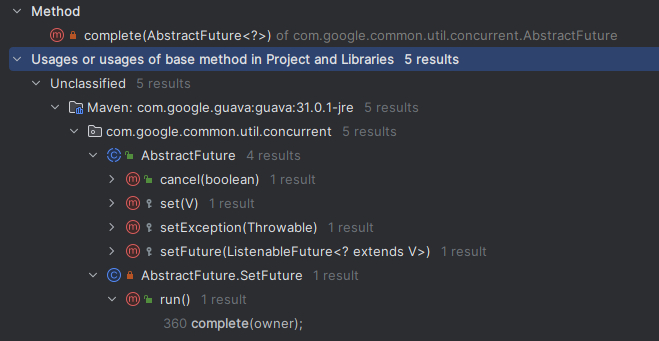MoreExecutors
directExecutor
ExecutorService executor = Executors.newSingleThreadExecutor();
SettableFuture<Integer> future = SettableFuture.create();
// 使用其他线程去 set 对应的结果。
executor.submit(() -> {
future.set(1);
});
Futures.addCallback(future, new FutureCallback<>() {
@Override
public void onSuccess(Integer result) {
// main线程执行的
System.out.println("result=" + result + "线程名:" + Thread.currentThread().getName());//main
}
@Override
public void onFailure(Throwable t) {
}
}, MoreExecutors.directExecutor());执行 callback 的线程池这里指定为 MoreExecutors#directExecutor ,那么这里执行打印 result 的线程是主线程
在 MoreExecutors#directExecutor 中,可以看到定义是这样的:
public final class MoreExecutors {
// 省略了类内其他成员
public static Executor directExecutor() {
return DirectExecutor.INSTANCE;
}
}以及
@GwtCompatible
@ElementTypesAreNonnullByDefault
enum DirectExecutor implements Executor {
INSTANCE;
@Override
public void execute(Runnable command) {
command.run();
}
@Override
public String toString() {
return "MoreExecutors.directExecutor()";
}
}MoreExecutors#directExecutor 其实是一个假的线程池,表示直接执行。
再看下面这个例子:
ExecutorService executor = Executors.newSingleThreadExecutor();
SettableFuture<Integer> future = SettableFuture.create();
// 使用其他线程去 set 对应的结果。
executor.submit(() -> {
// 增加线程 sleep 的逻辑。
try {
Thread.sleep(1000);
} catch (InterruptedException e) {
e.printStackTrace();
}
future.set(1);
});
Futures.addCallback(future, new FutureCallback<>() {
@Override
public void onSuccess(Integer result) {
// 此时就会被 executor 的线程执行
System.out.println("result=" + result + "线程名:" + Thread.currentThread().getName());//此时还未打印出来,主线程就结束了
}
@Override
public void onFailure(Throwable t) {
}
}, MoreExecutors.directExecutor());那么这里清晰了:
- 如果 future 已经完成,那么
MoreExecutor#directExecutor表示当前线程; - 如果 future 未完成,那么
MoreExecutor#directExecutor就是未来完成 future 的线程。
因此其实具体执行回调的线程某种程度上是不确定的
ListenableFuture
引言
jdk原生的future已经提供了异步操作,但是不能直接回调。guava对future进行了增强,核心接口就是ListenableFuture。JDK8从guava中吸收了精华新增的类CompletableFuture,也可以直接看这个类的学习。
JUC 的 Future 接口提供了一种异步获取任务执行结果的机制,表示一个异步计算的结果。
ExecutorService executor = Executors.newFixedThreadPool(1);
Future<String> future = executor.submit(() -> {
// 执行异步任务,返回一个结果
return "Task completed";
});
// Blocked
String result = future.get();Executor 实际返回的是实现类 FutureTask,它同时实现了 Runnable 接口,因此可以手动创建异步任务。
FutureTask<String> futureTask = new FutureTask<>(new Callable<String>() {
@Override
public String call() throws Exception {
return "Hello";
}
});
new Thread(futureTask).start();
System.out.println(futureTask.get());而 Guava 提供的 ListenableFuture 更进一步,允许注册回调,在任务完成后自动执行,实际也是使用它的实现类 ListenableFutureTask。
// 装饰原始的线程池
ListeningExecutorService listeningExecutorService = MoreExecutors.listeningDecorator(Executors.newFixedThreadPool(1));
ListenableFuture<String> future = listeningExecutorService.submit(() -> {
// int i = 1 / 0;
return "Hello";
});
// 添加回调 1
Futures.addCallback(future, new FutureCallback<String>() {
// 任务成功时的回调
@Override
public void onSuccess(String result) {
System.out.println(result);
}
// 任务失败时的回调
@Override
public void onFailure(Throwable t) {
System.out.println("Error: " + t.getMessage());
}
}, listeningExecutorService);
// 添加回调 2
future.addListener(new Runnable() {
@Override
public void run() {
System.out.println("Done");
}
}, listeningExecutorService);回调源码剖析
先看下ListenableFuture接口定义:
public interface ListenableFuture<V> extends Future<V> {
void addListener(Runnable listener, Executor executor);
}可以看到,这个接口在Future接口的基础上增加了addListener方法,允许我们注册回调函数。当然,在编程时可能不会直接使用这个接口,因为这个接口只能传Runnable实例。
addListener方法
@Override
public void addListener(Runnable listener, Executor executor) {
checkNotNull(listener, "Runnable was null.");
checkNotNull(executor, "Executor was null.");
// Checking isDone and listeners != TOMBSTONE may seem redundant, but our contract for
// addListener says that listeners execute 'immediate' if the future isDone(). However, our
// protocol for completing a future is to assign the value field (which sets isDone to true) and
// then to release waiters, followed by executing afterDone(), followed by releasing listeners.
// That means that it is possible to observe that the future isDone and that your listeners
// don't execute 'immediately'. By checking isDone here we avoid that.
// A corollary to all that is that we don't need to check isDone inside the loop because if we
// get into the loop we know that we weren't done when we entered and therefore we aren't under
// an obligation to execute 'immediately'.
if (!isDone()) {
Listener oldHead = listeners; // 获取当前监听器的头结点
if (oldHead != Listener.TOMBSTONE) {// 检查当前的头节点是否是TOMBSTONE。TOMBSTONE用来表示监听器列表不再接受新的监听器,通常是因为Future已经完成。
Listener newNode = new Listener(listener, executor);//通过这个listener新增一个一个节点,节点中包含executor
do {
newNode.next = oldHead;//将newNode.next指向当前头结点,此时newNode就是头结点
if (ATOMIC_HELPER.casListeners(this, oldHead, newNode)) {//检查头节点是否更新成功
return;//更新成功就可以返回了
}
oldHead = listeners; // 重新执行 头插法
} while (oldHead != Listener.TOMBSTONE);// 如果头节点变成了TOMBSTONE,则退出循环;并且
}
}
// If we get here then the Listener TOMBSTONE was set, which means the future is done, call
// the listener.
executeListener(listener, executor);//执行到这里意味着监听器TOMBSTONE就设置好了,也就是future已经完成,可以直接调用监听器
}这里其实就是在添加listener的方法中首先检查Future是否已经完成:
- 如果Future已经完成,那么就没有必要添加新的监听器,直接executeListener。
- 如果future没有完成,那么会新建一个Listener节点,并插入到链表头部(Listener就是一个链表)
如果已经完成,会直接执行executeListner 方法
private static void executeListener(Runnable runnable, Executor executor) {
try {
executor.execute(runnable);//直接使用listener拥有的线程executor执行
} catch (Exception e) { // sneaky checked exception
// Log it and keep going -- bad runnable and/or executor. Don't punish the other runnables if
// we're given a bad one. We only catch Exception because we want Errors to propagate up.
log.get()
.log(
Level.SEVERE,
"RuntimeException while executing runnable "
+ runnable
+ " with executor "
+ executor,
e);
}
}那么如果没有完成呢,在listener链表中的什么时候会执行?看后续的回调函数的触发内容
addCallback方法
Futures类还提供了另一个回调方法:addCallback方法
public static <V> void addCallback(
final ListenableFuture<V> future,
final FutureCallback<? super V> callback,
Executor executor) {
Preconditions.checkNotNull(callback);
future.addListener(new CallbackListener<V>(future, callback), executor);//调用了addListener方法
}这里调用了ListenableFuture接口的addListener方法,传入了一个CallbackListener实例。而这个实例由需要传入future和一个Callback实例,所以这个回调是可以拿到返回值的。本质上是guava基于Runnable封了一个回调接口。
看下这个CallbackListener接口:
private static final class CallbackListener<V> implements Runnable {
final Future<V> future;
final FutureCallback<? super V> callback;
CallbackListener(Future<V> future, FutureCallback<? super V> callback) {
this.future = future;
this.callback = callback;
}
@Override
public void run() {//回调时的逻辑
if (future instanceof InternalFutureFailureAccess) {
Throwable failure =
InternalFutures.tryInternalFastPathGetFailure((InternalFutureFailureAccess) future);
if (failure != null) {
callback.onFailure(failure);
return;
}
}
final V value;
try {
value = getDone(future);//获取返回值
} catch (ExecutionException e) {
callback.onFailure(e.getCause());//如果发生了异常,则会调用onFailure方法通知异常
return;
} catch (RuntimeException | Error e) {
callback.onFailure(e);//如果发生了异常,则会调用onFailure方法通知异常
return;
}
callback.onSuccess(value);//将返回值调用FutureCallback实例的onSuccess方法执行注册的回调逻辑
}
}那么这个回调函数什么时候会执行?看后续的回调函数的触发内容
回调函数的触发
那么这些回调方法什么时候会触发呢?
private static void complete(AbstractFuture<?> param) {
// Declare a "true" local variable so that the Checker Framework will infer nullness.
AbstractFuture<?> future = param;//获取future
Listener next = null;
outer:
while (true) {
future.releaseWaiters();//通知所有执行的方法
// We call this before the listeners in order to avoid needing to manage a separate stack data
// structure for them. Also, some implementations rely on this running prior to listeners
// so that the cleanup work is visible to listeners.
// afterDone() should be generally fast and only used for cleanup work... but in theory can
// also be recursive and create StackOverflowErrors
future.afterDone();
// push the current set of listeners onto next
next = future.clearListeners(next);//反转listener链表
future = null;
while (next != null) {
Listener curr = next;//获取当前listener
next = next.next;
/*
* requireNonNull is safe because the listener stack never contains TOMBSTONE until after
* clearListeners.
*/
Runnable task = requireNonNull(curr.task);
if (task instanceof SetFuture) {
SetFuture<?> setFuture = (SetFuture<?>) task;
// We unwind setFuture specifically to avoid StackOverflowErrors in the case of long
// chains of SetFutures
// Handling this special case is important because there is no way to pass an executor to
// setFuture, so a user couldn't break the chain by doing this themselves. It is also
// potentially common if someone writes a recursive Futures.transformAsync transformer.
future = setFuture.owner;
if (future.value == setFuture) {
Object valueToSet = getFutureValue(setFuture.future);
if (ATOMIC_HELPER.casValue(future, setFuture, valueToSet)) {
continue outer;
}
}
// other wise the future we were trying to set is already done.
} else {
/*
* requireNonNull is safe because the listener stack never contains TOMBSTONE until after
* clearListeners.
*/
executeListener(task, requireNonNull(curr.executor));// 交给listener拥有的线程池进行处理
}
}
break;
}
}那哪些方法会来调用这个complete方法呢?
Service
Guava 的 Service 框架是一个用于管理服务生命周期的轻量级框架,可以帮助我们把异步操作封装成一个Service服务。让这个服务有了运行状态(也可以理解成生命周期),这样可以实时了解当前服务的运行状态。同时还可以添加监听器来监听服务运行状态之间的变化。
Guava里面的服务有五种状态,如下所示:
- Service.State.NEW: 服务创建状态
- Service.State.STARTING: 服务启动中
- Service.State.RUNNING:服务启动完成,正在运行中
- Service.State.STOPPING: 服务停止中
- Service.State.TERMINATED: 服务停止完成,结束
所有的服务都需要实现Service接口,里面包括了服务需要实现的一些基本方法,以下是Service接口:
public interface Service {
//启动当前服务,只有当服务的状态是NEW的情况下才可以启动,否则抛出IllegalStateException异常
@CanIgnoreReturnValue
Service startAsync();
//判断当前服务是否处在运行状态 (RUNNING)
boolean isRunning();
//获取当前服务的状态
Service.State state();
//停止当前服务
@CanIgnoreReturnValue
Service stopAsync();
// 等待当前服务到达RUNNING状态
void awaitRunning();
// 在指定的时间内等待当前服务到达RUNNING状态,如果在指定时间没有达到则抛出TimeoutException
void awaitRunning(long timeout, TimeUnit unit) throws TimeoutException;
// 等待当前服务到达TERMINATED状态
void awaitTerminated();
//在指定的时间内等待当前服务达到TERMINATED状态,
void awaitTerminated(long timeout, TimeUnit unit) throws TimeoutException;
// 获取服务器失败的原因,在服务是FAILED的状态的时候调用该函数,否则抛出IllegalStateException异常
Throwable failureCause();
//监听当前服务的状态改变,executor参数表示,监听回调函数在哪里执行
void addListener(Service.Listener listener, Executor executor);
}那应该怎么来使用Service,需要实现的异步逻辑包装成服务呢.Guava里面已经给提供了三个基础实现类:
- AbstractService
- AbstractExecutionThreadService
- AbstractScheduledService
AbstractExecutionThreadService
AbstractExecutionThreadService可以把一个具体的异步操作封装成Service服务。说白了就是把之前在线程的实现逻辑封装成服务,把之前线程的具体实现逻辑搬到AbstractExecutionThreadService的实现方法run()方法去执行。
常用方法介绍
首先AbstractExecutionThreadService实现了Service,Service的方法在AbstractExecutionThreadService里面都有,AbstractExecutionThreadService新加了一些方法。如下所示:
public class AbstractExecutionThreadService {
// 开始执行服务逻辑的时候会调用,可以在里面做一些初始化的操作
protected void startUp() throws Exception;
// 当前服务需要执行的具体逻辑
protected abstract void run() throws Exception;
// 服务停止之后会调用的函数,可以在里面做 一些释放资源的处理
protected void shutDown() throws Exception {}
//比如在run方法里面有一个无线循环,可以在这个方法里面置状态,退出无线循环,让服务真正停止
//调stopAsync函数的时候,会调用该方法
protected void triggerShutdown() {}
...
}AbstractExecutionThreadService类里面最重要的就是run()方法了,这个方法是服务需要具体实现的方法,服务需要处理的具体逻辑在这个方法里面做。
具体使用
public class AbstractExecutionThreadServiceImpl extends AbstractExecutionThreadService {
private volatile boolean running = true; //声明一个状态
@Override
protected void startUp() {
//TODO: 做一些初始化操作
}
@Override
public void run() {
// 具体需要实现的业务逻辑,会在线程中执行
while (running) {
try {
// 等待2s
Uninterruptibles.sleepUninterruptibly(2, TimeUnit.SECONDS);
System.out.println("do our work.....");
} catch (Exception e) {
//TODO: 处理异常,这里如果抛出异常,会使服务状态变为failed同时导致任务终止。
}
}
}
@Override
protected void triggerShutdown() {
//TODO: 如果的run方法中有无限循环,可以在这里置状态,让其退出无限循环,stopAsync()里面会调用到该方法
running = false; //这里改变状态值,run方法中就能够得到响应。
}
@Override
protected void shutDown() throws Exception {
//TODO: 可以做一些清理操作,比如关闭连接。shutDown() 是在线程的具体实现里面调用的
}
}AbstractScheduledService
AbstractScheduledService可以把周期性的任务封装成一个服务。线程池也有一个周期性的线程池么,两者是一一对应的.
常用方法介绍
AbstractScheduledService也是一个服务所以Service里面的方法AbstractScheduledService也都有,同时,AbstractScheduledService也新增了一些其它方法
public class AbstractScheduledService {
...
//周期任务的具体逻辑在这个里面实现
protected abstract void runOneIteration() throws Exception;
//启动周期任务之前调用,可以在里面做一些初始化的操作
protected void startUp() throws Exception;
//周期任务停止之后调用,可以在里面做 一些释放资源的处理
protected void shutDown() throws Exception {}
//指定当前周期任务在哪个ScheduledExecutorService里面调用
//Scheduler.newFixedDelaySchedule()
protected abstract Scheduler scheduler();
...
}具体使用
自定义一个类继承AbstractScheduledService,实现一个非常简单的周期性任务.
public class AbstractScheduledServiceImpl extends AbstractScheduledService {
@Override
protected void startUp() throws Exception {
//TODO: 做一些初始化操作
}
@Override
protected void shutDown() throws Exception {
//TODO: 可以做一些清理操作,比如关闭连接。shutDown() 是在线程的具体实现里面调用的
}
@Override
protected void runOneIteration() throws Exception {
// 每次周期任务的执行逻辑
try {
System.out.println("do work....");
} catch (Exception e) {
//TODO: 处理异常,这里如果抛出异常,会使服务状态变为failed同时导致任务终止。
}
}
@Override
protected Scheduler scheduler() {
// 5s执行一次的Scheduler
return Scheduler.newFixedDelaySchedule(1, 5, TimeUnit.SECONDS);
}
}
ServiceManager
ServiceManager是用来管理多个服务的,让对多个服务的操作变的更加方便,比如可以同时去启动多个服务,同时去停止多个服务等等。
常用方法介绍
public class ServiceManager {
//构造函数,管理多个Service服务
public ServiceManager(Iterable<? extends Service> services);
//给ServiceManager增加状态监听器
public void addListener(Listener listener, Executor executor);
public void addListener(Listener listener);
//开始启动ServiceManager里面所有Service服务
public ServiceManager startAsync();
//等待ServiceManager里面所有Service服务达到Running状态
public void awaitHealthy();
public void awaitHealthy(long timeout, TimeUnit unit) throws TimeoutException;
//停止ServiceManager里面所有Service服务
public ServiceManager stopAsync();
//等待ServiceManager里面所有Service服务达到终止状态
public void awaitStopped();
public void awaitStopped(long timeout, TimeUnit unit) throws TimeoutException;
//ServiceManager里面所有Service服务是否都达到了Running状态
public boolean isHealthy();
//以状态为索引返回当前所有服务的快照
public ImmutableMultimap<State, Service> servicesByState();
//返回一个Map对象,记录被管理的服务启动的耗时、以毫秒为单位,同时Map默认按启动时间排序
public ImmutableMap<Service, Long> startupTimes();
}具体使用
@Test
public void serviceManagerTest() {
// 定义两个服务
AbstractExecutionThreadServiceImpl service0 = new AbstractExecutionThreadServiceImpl();
AbstractScheduledServiceImpl service1 = new AbstractScheduledServiceImpl();
List<Service> serviceList = Lists.newArrayList(service0, service1);
// ServiceManager里面管理这两个服务
ServiceManager serviceManager = new ServiceManager(serviceList);
// 添加监听
serviceManager.addListener(new ServiceManager.Listener() {
@Override
public void healthy() {
super.healthy();
System.out.println("healthy");
}
@Override
public void stopped() {
super.stopped();
System.out.println("stopped");
}
@Override
public void failure(Service service) {
super.failure(service);
System.out.println("failure");
}
});
// 启动服务,等待所有的服务都达到running状态
serviceManager.startAsync().awaitHealthy();
// 等待30s
Uninterruptibles.sleepUninterruptibly(30, TimeUnit.SECONDS);
// 停止服务
serviceManager.stopAsync().awaitStopped();
}往期推荐
- 《SpringBoot》EasyExcel实现百万数据的导入导出
- 《SpringBoot》史上最全SpringBoot相关注解介绍
- Spring框架IoC核心详解
- 万字长文带你窥探Spring中所有的扩展点
- 如何实现一个通用的接口限流、防重、防抖机制
- 万字长文带你深入Redis底层数据结构
- volatile关键字最全原理剖析
__EOF__
- 本文作者: Seven
- 本文链接: https://www.cnblogs.com/seven97-top/p/18808520
- 关于博主: Seven的菜鸟成长之路
- 版权声明: 本博客所有文章除特别声明外,均采用 BY-NC-SA 许可协议。转载请注明出处!
- 声援博主: 如果您觉得文章对您有帮助,可以点击文章右下角【推荐】一下。



























 72
72

 被折叠的 条评论
为什么被折叠?
被折叠的 条评论
为什么被折叠?








